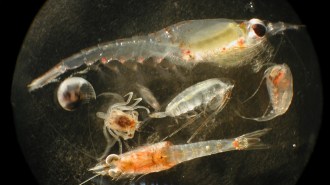Field studies in Russia indicate that massive peat bogs there may have been a major source of atmospheric methane just after the end of the last ice age.
Chemical analyses of the gases trapped in ice cores drilled from sites around the globe have revealed that the concentration of methane in Earth’s atmosphere increased dramatically between 11,500 and 9,000 years ago. Subtle differences among the cores suggest that much of that new methane–whatever generated it–originated in the Northern Hemisphere, says Glen M. MacDonald, a paleoclimatologist at the University of California, Los Angeles (UCLA).
Various scientists previously suggested that the planet-warming greenhouse gas came from tropical wetlands or the decomposition of methane hydrates, icelike seafloor deposits that hold vast quantities of methane. Not many researchers considered that peat lands, a prodigious modern-day source of methane, could be responsible for the post–ice age spike in that gas’ concentration, MacDonald notes. Most of the bogs and fens of North America and Europe had seemed to begin accumulating vegetation about 1,500 years after atmospheric methane concentrations started to rise.
Now, MacDonald and his colleagues have analyzed 87 peat cores pulled from the lowlands of western Siberia–a 600,000-square-kilometer peat land ecosystem–in the summers of 1999, 2000, and 2001. Carbon dating techniques indicate that the bottom layers of peat in many of those cores are up to 11,500 years old, which suggests that the region’s bogs were growing throughout the period when the ancient methane spike occurred.
Each square meter of modern peat land generates up to 195 milligrams of methane per day. Although that sounds trifling, the extensive bogs throughout the Siberian lowlands could together add 14 million metric tons of the greenhouse gas to the atmosphere each year. When the bogs first accumulated material, their rates of methane production may have been up to six times today’s rate because plant species typical of shallow bogs produce the gas more efficiently than plants at the surface of older bogs do. MacDonald and his colleagues present their findings in the Jan. 16 Science.
Analyses of the peat cores suggest that the western-Siberian bogs have been steadily accumulating vegetation since the last ice age, says Laurence C. Smith of UCLA, a coauthor of the report.
Overall, these peat lands may hold up to a quarter of the carbon stored in soils worldwide throughout the past 11,500 years.
Peat lands have been ignored in many studies of the planet’s carbon cycle in part because it’s so difficult for scientists to work there, says Nigel Roulet of McGill University in Montreal. The new research shows that the western-Siberian bogs formed at the right time and right latitude and were large enough to explain much of the post–ice age methane spike, he notes.
MacDonald and his colleagues have produced “a nice piece of work” that makes clear the connections between biosphere function, atmospheric chemistry, and climate change, says Zicheng Yu of Lehigh University in Bethlehem, Pa.
****************
If you have a comment on this article that you would like considered for publication in Science News, send it to editors@sciencenews.org. Please include your name and location.







